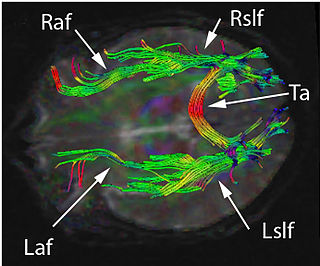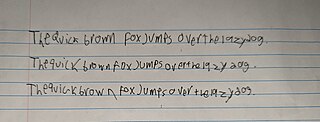Related Research Articles

In aphasia, a person may be unable to comprehend or unable to formulate language because of damage to specific brain regions. The major causes are stroke and head trauma; prevalence is hard to determine but aphasia due to stroke is estimated to be 0.1–0.4% in the Global North. Aphasia can also be the result of brain tumors, epilepsy, autoimmune neurological diseases, brain infections, or neurodegenerative diseases.

Dyslexia, previously known as word blindness, is a learning disability that affects either reading or writing. Different people are affected to different degrees. Problems may include difficulties in spelling words, reading quickly, writing words, "sounding out" words in the head, pronouncing words when reading aloud and understanding what one reads. Often these difficulties are first noticed at school. The difficulties are involuntary, and people with this disorder have a normal desire to learn. People with dyslexia have higher rates of attention deficit hyperactivity disorder (ADHD), developmental language disorders, and difficulties with numbers.
Agraphia is an acquired neurological disorder causing a loss in the ability to communicate through writing, either due to some form of motor dysfunction or an inability to spell. The loss of writing ability may present with other language or neurological disorders; disorders appearing commonly with agraphia are alexia, aphasia, dysarthria, agnosia, acalculia and apraxia. The study of individuals with agraphia may provide more information about the pathways involved in writing, both language related and motoric. Agraphia cannot be directly treated, but individuals can learn techniques to help regain and rehabilitate some of their previous writing abilities. These techniques differ depending on the type of agraphia.

Anomic aphasia is a mild, fluent type of aphasia where individuals have word retrieval failures and cannot express the words they want to say. By contrast, anomia is a deficit of expressive language, and a symptom of all forms of aphasia, but patients whose primary deficit is word retrieval are diagnosed with anomic aphasia. Individuals with aphasia who display anomia can often describe an object in detail and maybe even use hand gestures to demonstrate how the object is used, but cannot find the appropriate word to name the object. Patients with anomic aphasia have relatively preserved speech fluency, repetition, comprehension, and grammatical speech.

Dysgraphia is a neurological disorder and learning disability that concerns impairments in written expression, which affects the ability to write, primarily handwriting, but also coherence. It is a specific learning disability (SLD) as well as a transcription disability, meaning that it is a writing disorder associated with impaired handwriting, orthographic coding and finger sequencing. It often overlaps with other learning disabilities and neurodevelopmental disorders such as speech impairment, attention deficit hyperactivity disorder (ADHD) or developmental coordination disorder (DCD).
Reading for special needs has become an area of interest as the understanding of reading has improved. Teaching children with special needs how to read was not historically pursued due to perspectives of a Reading Readiness model. This model assumes that a reader must learn to read in a hierarchical manner such that one skill must be mastered before learning the next skill. This approach often led to teaching sub-skills of reading in a decontextualized manner. This style of teaching made it difficult for children to master these early skills, and as a result, did not advance to more advanced literacy instruction and often continued to receive age-inappropriate instruction.
A reading disability is a condition in which a person displays difficulty reading. Examples of reading disabilities include: developmental dyslexia, And alexia,
Pure alexia, also known as agnosic alexia or alexia without agraphia or pure word blindness, is one form of alexia which makes up "the peripheral dyslexia" group. Individuals who have pure alexia have severe reading problems while other language-related skills such as naming, oral repetition, auditory comprehension or writing are typically intact.
Deep dyslexia is a form of dyslexia that disrupts reading processes. Deep dyslexia may occur as a result of a head injury, stroke, disease, or operation. This injury results in the occurrence of semantic errors during reading and the impairment of nonword reading.
Apraxia of speech (AOS), also called verbal apraxia, is a speech sound disorder affecting an individual's ability to translate conscious speech plans into motor plans, which results in limited and difficult speech ability. By the definition of apraxia, AOS affects volitional movement pattern. However, AOS usually also affects automatic speech.
Brian Lewis Butterworth FBA is emeritus professor of cognitive neuropsychology in the Institute of Cognitive Neuroscience at University College London, England. His research has ranged from speech errors and pauses, short-term memory deficits, reading and the dyslexias both in alphabetic scripts and Chinese, and mathematics and dyscalculia. He has also pioneered educational neuroscience, notably in the study of learners with special educational needs.
The history of dyslexia research spans from the late 1800s to the present.
Dyslexia is a reading disorder wherein an individual experiences trouble with reading. Individuals with dyslexia have normal levels of intelligence but can exhibit difficulties with spelling, reading fluency, pronunciation, "sounding out" words, writing out words, and reading comprehension. The neurological nature and underlying causes of dyslexia are an active area of research. However, some experts believe that the distinction of dyslexia as a separate reading disorder and therefore recognized disability is a topic of some controversy.
Dyslexia is a complex, lifelong disorder involving difficulty in learning to read or interpret words, letters and other symbols. Dyslexia does not affect general intelligence, but is often co-diagnosed with ADHD. There are at least three sub-types of dyslexia that have been recognized by researchers: orthographic, or surface dyslexia, phonological dyslexia and mixed dyslexia where individuals exhibit symptoms of both orthographic and phonological dyslexia. Studies have shown that dyslexia is genetic and can be passed down through families, but it is important to note that, although a genetic disorder, there is no specific locus in the brain for reading and writing. The human brain does have language centers, but written language is a cultural artifact, and a very complex one requiring brain regions designed to recognize and interpret written symbols as representations of language in rapid synchronization. The complexity of the system and the lack of genetic predisposition for it is one possible explanation for the difficulty in acquiring and understanding written language.
Rapid automatized naming (RAN) is a task that measures how quickly individuals can name aloud objects, pictures, colors, or symbols. Variations in rapid automatized naming time in children provide a strong predictor of their later ability to read, and is independent from other predictors such as phonological awareness, verbal IQ, and existing reading skills. Importantly, rapid automatized naming of pictures and letters can predict later reading abilities for pre-literate children.
Word recognition, according to Literacy Information and Communication System (LINCS) is "the ability of a reader to recognize written words correctly and virtually effortlessly". It is sometimes referred to as "isolated word recognition" because it involves a reader's ability to recognize words individually from a list without needing similar words for contextual help. LINCS continues to say that "rapid and effortless word recognition is the main component of fluent reading" and explains that these skills can be improved by "practic[ing] with flashcards, lists, and word grids".
The mental lexicon is a component of the human language faculty that contains information regarding the composition of words, such as their meanings, pronunciations, and syntactic characteristics. The mental lexicon is used in linguistics and psycholinguistics to refer to individual speakers' lexical, or word, representations. However, there is some disagreement as to the utility of the mental lexicon as a scientific construct.
Phonological dyslexia is a reading disability that is a form of alexia, resulting from brain injury, stroke, or progressive illness and that affects previously acquired reading abilities. The major distinguishing symptom of acquired phonological dyslexia is that a selective impairment of the ability to read pronounceable non-words occurs although the ability to read familiar words is not affected. It has also been found that the ability to read non-words can be improved if the non-words belong to a family of pseudohomophones.
The dual-route theory of reading aloud was first described in the early 1970s. This theory suggests that two separate mental mechanisms, or cognitive routes, are involved in reading aloud, with output of both mechanisms contributing to the pronunciation of a written stimulus.
Kate Nation is an experimental psychologist and expert on language and literacy development in school age children. She is Professor of Experimental Psychology and Fellow of St. John's College of the University of Oxford, where she directs the ReadOxford project and the Language and Cognitive Development Research Group.
References
- ↑ Carlson, Neil (2010). Psychology the Science of Behaviour [4th Canadian ed.]. Toronto, On. Canada: Pearson Canada Inc. pp. 310. ISBN 978-0-205-64524-4.
- ↑ Cherney LR (2004). "Aphasia, alexia, and oral reading". Top Stroke Rehabil. 11 (1): 22–36. doi:10.1310/VUPX-WDX7-J1EU-00TB. PMID 14872397. S2CID 218644618.
- 1 2 Playfoot, D (2014). "Naming acronyms: The influence of reading context in skilled reading and surface dyslexia" (PDF). Aphasiology. 28 (12): 1448–1463. doi:10.1080/02687038.2014.939517. S2CID 145403689.
- 1 2 Wang, H.C. (2015). "Orthographic learning in developmental surface and phonological dyslexia". Cognitive Neuropsychology. 32 (2): 58–79. doi:10.1080/02643294.2014.1003536. PMID 25639641. S2CID 22107257.
- ↑ Law, Caroline; Cupples, Linda (18 August 2015). "Thinking outside the boxes: Using current reading models to assess and treat developmental surface dyslexia". Neuropsychological Rehabilitation. 27 (2): 149–195. doi:10.1080/09602011.2015.1064453. PMID 26282550. S2CID 22436956.
